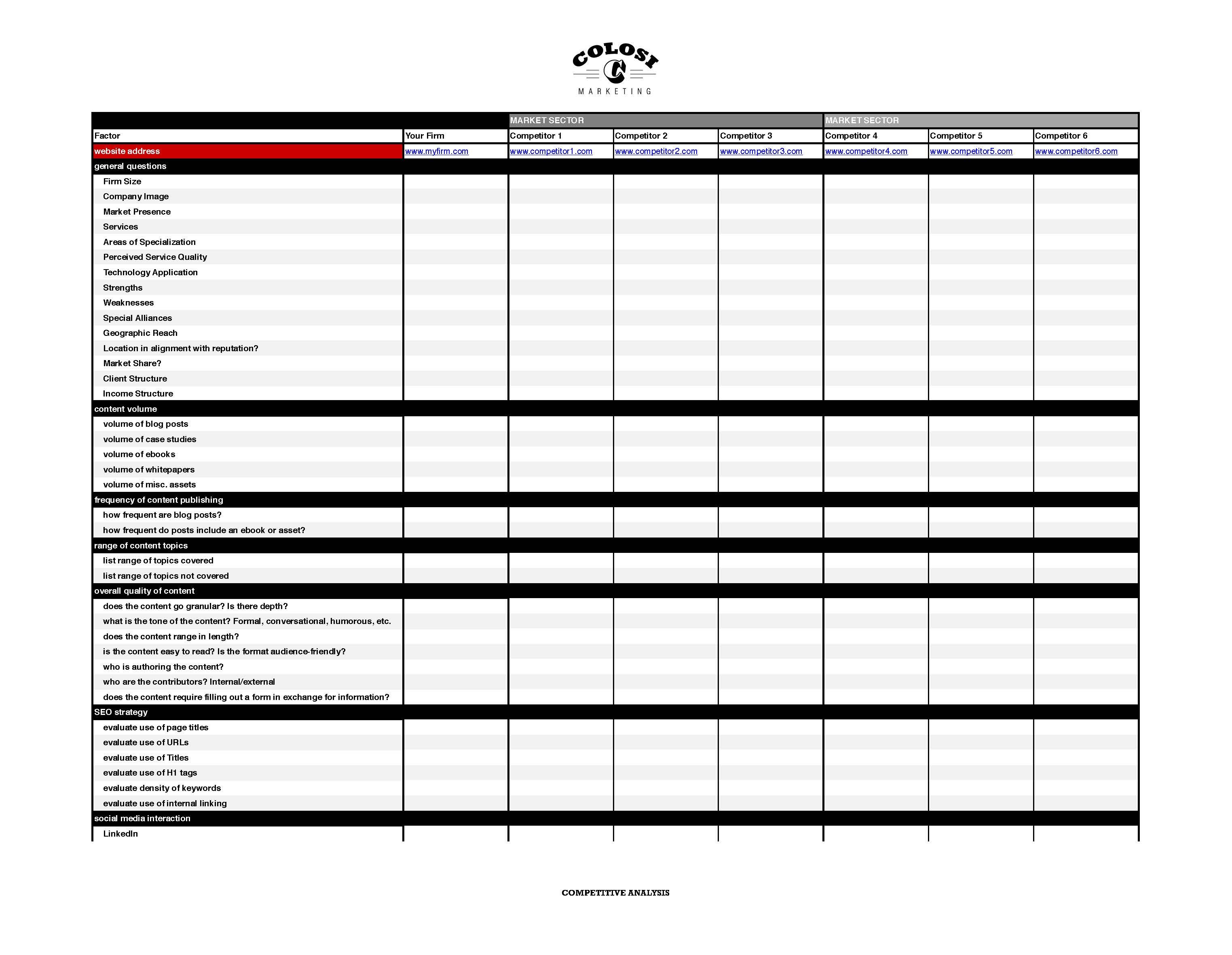Analyze the Competition to Craft a Formidable Content Marketing Strategy
Once a firm identifies the ideal client profiles, it is time to discover what distinguishes a professional services firm from the competition. The market is subject to perpetual change. Client behaviors change, and new rivals will always enter the market, altering the competitive landscape. Analyzing the competition is the first step to crafting a formidable content marketing strategy. Let’s begin with the questions that help shed light on how a firm shapes up against the competition.
Questions to answer about the competition.
- What is the size of the firm?
- What is the image of the firm?
- How strong is the firm’s market presence?
- What are the firm’s services and areas of specialization?
- What is the perceived quality of the services?
- Does the firm use cutting edge technologies to perform services?
- What are the firm's service strengths and weaknesses?
- Are there special alliances associated with this firm? If yes, list the alliances.
- What is the firm’s geographic reach?
- Is the firm’s location in alignment with the it’s reputation?
- How large is the actual and projected volume in the firm’s targeted geography? (i.e. What is the firm's market share?)
- What is the client and income structure?
Source: Uploaded by user via Jim on Pinterest
Competitive analysis should be recorded in the form of a matrix that contains Competitive analysis should be recorded in the form of a matrix that contains information on the competition and makes possible a direct comparison to one’s firm. Thoroughly research each market segment and gather data from trade publications, magazines, clients, and alliances. The information must be evaluated and illustrated as a firm resource. A firm’s market leader should also be a resource for all analyses, particularly when evaluating the competition.
Once the client profiles and competitive matrix become reliable marketing and business development resources, it is time to dig deeper by evaluating the competition’s content. If a firm is looking to apply inbound marketing strategies, it is important to determine how to outperform competitors with scintillating content.
Taking the time to look at the competition’s content with a magnifying glass is a time investment. With a closer look, a more precise content marketing strategy can be devised to compete and eventually overtake online competitors. With the competitive matrix, evaluating the competition’s content is time.
Locate the competition’s available content. Analyzing the competition’s content begins by visiting the competitor’s website. Once you’ve arrived at the website, it is time to browse and click through the navigation and sub-navigations. Make a notation of where the content is located. Some areas where you may encounter content assets include blog posts, whitepapers, ebooks, videos, webinars, podcasts, slide decks, visual content, press releases, press kits, case studies, and datasheets. Look at these assets and make a note of the URLs where you find these assets.
Inspect the content.
Take a look at the volume of content by type. In other words, quantify the number of blog posts. Does the competition publish case studies, ebooks, or whitepapers? Once the competition’s volume of content assets is discovered, it is easy to understand what is needed to build a formidable collection of content assets that would require a strong content creation team to overtake.
Determine the frequency of publishing content by type. Are the blog posts frequent? How often do the blog posts incorporate an ebook or content asset? While a date may not be provided on all the content, it is a good practice to understand the publishing frequency by content asset type to determine the competitor's activity level.
Determine the range of topics. Once a competitor’s topic range is discovered, it is easy to list topics that have not been discussed or capitalized. In effect, develop a content strategy to cover a series of topics to gain an infallible strategic position by hitting on the topics the competition has neglected.
Source: thinspiration-x.tumblr.com via Laura on Pinterest
Assess the overall quality of the content. Once you located the content and developed an understanding of the volume, range and frequency of the topics discussed, it is time to determine the overall quality of the content. The following are a few questions that will help determine the quality of the content asset:
- Does the content go granular? Is there a range of depth with each of the topics discussed?
- What is the tone of the content? Is it formal, conversational, humorous, etc?
- Does the content range in length?
- Is the content easy to read? Is the format audience-friendly?
- Who is authoring the content? Does the competition have contributors? Are the authors internal employees or are they guests?
- Does their content require a form? Is the content mostly form-free? Or is the content a blend of the two?
Figure out the competition’s SEO strategy. If the competition is a frequent blogger that publishes quality content that covers a range of topics but does not optimize the content, the competition is missing out on a key component to being found by search engines. It is possible to assess a competitor’s level of SEO by looking at the following areas:
- Page title
- URL
- Title
- H1 Tags
- Keyword density
- Image alt text
- Use of internal linking
Determine to What Level Social Media Play in the Competition’s Content Strategy. Social media should be a part of the content strategy. Visit the competition’s social media sites to determine their presence. As a baseline, take a look at the competitor's level of interaction on the following social sites:
- YouTube
- Google+
Some of these social media sites may be outside of your discipline. However, it is good to see if the competition exists and to what extent. If the competition is effective in their exchange, it may be time to evaluate what they are doing right. For each social site, note how often they publish and how often fans converse.
Once the competitive analysis is complete, a firm knows where it stands among the competition in content creation efforts. A firm can instantly identify areas to surpass the competition by looking at the findings.





